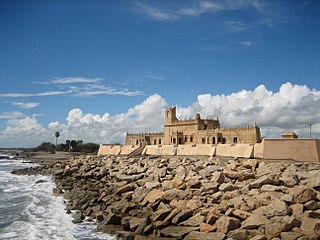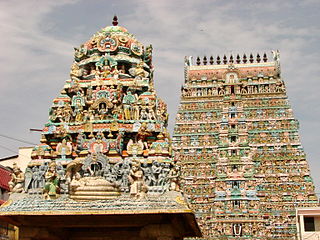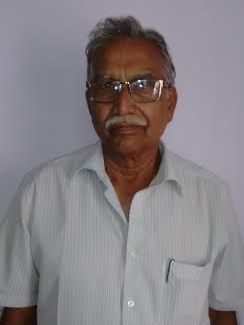
The Thanjavur cannon is one of the largest early modern cannons located in Thanjavur, Thanjavur district, Tamil Nadu, India.

The Thanjavur cannon is one of the largest early modern cannons located in Thanjavur, Thanjavur district, Tamil Nadu, India.
The Thanjavur cannon, also known as Rajagopala Beerangi, is a massive cannon kept on a mount in Beerangi Medu, Thanjavur, on the east rampart of the Thanjavur Fort. It is located at the heart of the city and located very near to the Peruvudaiyaar Temple. Autos and Buses are available to reach the place where it is kept. [1]
It was made with cutting-edge technology of its time. [2] The high standard of iron and steel technology in ancient and medieval India is reflected in the manufacture and use of numerous large iron objects, including forge-welded cannons. Such cannons are found in Mushirabad, Dacca (in Bangladesh), Bijapur, Gulbarga, and Thanjavur. Based on its weight and size, the cannon at Thanjavur is regarded as one of the largest forge-welded iron cannons in the world. [3] It takes fourth place in the list of Largest Cannons fired in the World History. It was named "Rajagopala Beerangi (Cannon)", but is popularly known as "Daasimettu Beerangi". It is placed on an elevated (25’high) defense barricade at the Eastern Rampart.
The cannon was cast in 1620 at Kollumedu. The metallurgical skills displayed speak volumes of the people in 17th century. It is said that Tamils' technical know how was used to cast the cannon. It was mounted in 1620 CE when Raghunatha Nayak ruled Thanjavur. [1] [4]
The nearly 400 year-old cannon, though exposed to sun and rain, has not rusted so far. It is 26 feet long and weighs 20 tonnes. It is forge welded and has not been made by casting. Its outer circle is 300 cm in diameter, while the inner circle is 150 cm in diameter. The inside of the barrel is made of 43 long iron plates and the outer of 94 iron rings. To lift the cannon, eight rings were attached on top, but only two survive today. It can fire a 1000 kg iron cannonball. [1]
This cannon was used in 1650 during the Nayak period to protect Thanjavur from enemies entering through the East Gate of the town. [1] From the site, one can see the Sarja madi (seven-floor structure) and the Arsenal tower of Nayak Palace on the western side. [4]

Kumbakonam, or Kudanthai, is a city municipal corporation in the Thanjavur district in the Indian state of Tamil Nadu. It is located 40 km (25 mi) from Thanjavur and 282 km (175 mi) from Chennai and is the headquarters of the Kumbakonam taluk of Thanjavur district. It is the second largest city in the district after Thanjavur. The city is bounded by two rivers, the Kaveri River to the north and Arasalar River to the south. Kumbakonam is known as a "Temple town" due to the prevalence of a number of temples here and is noted for its Mahamaham festival, which happens once in 12 years, attracting people from all over the country.

Thanjavur, also known as Thanjai, previously known as Tanjore, is a city in the Indian state of Tamil Nadu. It is the 11th biggest city in Tamil Nadu. Thanjavur is an important center of southern Indian religion, art, and architecture. Most of the Great Living Chola Temples, which are UNESCO World Heritage Monuments, are located in and around Thanjavur. The foremost among these, the Brihadeeswara Temple, built by the Chola emperor Rajaraja I, is located in the centre of the city. This temple has one of the largest bull statue in India carved out of a single granite rock called Nandi. Thanjavur is also home to Tanjore painting, a painting style unique to the region. Thanjavur is the headquarters of the Thanjavur District. The city is an important agricultural centre located in the Kaveri Delta and is known as the Rice bowl of Tamil Nadu. Thanjavur is administered by a municipal corporation covering an area of 36.31 km2 (14.02 sq mi) and had a population of 222,943. Roadways are the major means of transportation, while the city also has railway connectivity. The nearest airport is Tiruchirapalli International Airport, located 59.6 km (37.0 mi) away from the city. The nearest seaport is Karaikal, which is 94 km (58 mi) away from Thanjavur. The city first rose to prominence during the reign of the Cholas when it served as the capital of the empire. After the fall of the Cholas, the city was ruled by various dynasties such as the Mutharaiyar dynasty, the Pandyas, the Vijayanagar Empire, the Madurai Nayaks, the Thanjavur Nayaks, the Thanjavur Marathas and the British Empire. It has been a part of independent India since 1947.

Tharangambadi, formerly Tranquebar, is a town in the Mayiladuthurai district of the Indian state of Tamil Nadu on the Coromandel Coast. It lies 15 kilometres (9.3 mi) north of Karaikal, near the mouth of a distributary named Uppanar of the Kaveri River. Tranquebar was established on 19 November 1620 as the first Danish trading post in India. King Christian IV had sent his envoy Ove Gjedde who established contact with Raghunatha Nayak of Tanjore. An annual tribute was paid by the Danes to the Rajah of Tanjore until the colony of Tranquebar was sold to the British East India Company in 1845.

The formal definition of large-calibre artillery used by the United Nations Register of Conventional Arms (UNROCA) is "guns, howitzers, artillery pieces, combining the characteristics of a gun, howitzer, mortar, or multiple-launch rocket system, capable of engaging surface targets by delivering primarily indirect fire, with a calibre of 75 mm (3.0 in) and above". This definition, shared by the Arms Trade Treaty and the Treaty on Conventional Armed Forces in Europe, is updated from an earlier definition in United Nations General Assembly Resolution 46/36L, which set a threshold of 100 mm (3.9 in). Several grammatical changes were made to that latter in 1992 and the threshold was lowered in 2003 to yield the current definition, as endorsed by UN General Assembly Resolution 58/54.

Mannargudi is a town in Thiruvarur district in the Indian state of Tamil Nadu. It is the headquarters of the Mannargudi taluk. The town is located at a distance of 28 km (17 mi) from the district headquarters Thiruvarur, 36 km from Kumbakonam, 40 km from Thanjavur and 310 km (190 mi) from the state capital Chennai. Mannargudi is known for the Rajagopalaswamy temple, a prominent Vaishnavite shrine.

The Thanjavur Nayakdynasty were the rulers of Thanjavur in the 15th and 17th centuries. The Nayaks, who belonged to the Telugu-speaking Balija social group were originally appointed as provincial governors by the Vijayanagara Emperor in the 15th century, who divided the territory into Nayak kingdoms which were Madurai, Tanjore, Gingee and Kalahasthi. In the mid-15th century they became an independent kingdom, although they continued their alliance with the Vijayanagara Empire. The Thanjavur Nayaks were notable for their patronage of literature and the arts.

The bombard is a type of cannon or mortar which was used throughout the Middle Ages and the early modern period. Bombards were mainly large calibre, muzzle-loading artillery pieces used during sieges to shoot round stone projectiles at the walls of enemy fortifications, enabling troops to break in. Most bombards were made of iron and used gunpowder to launch the projectiles. There are many examples of bombards, including Mons Meg, the Dardanelles Gun, and the handheld bombard.

Fort Dansborg, locally called Danish Fort, is a Danish fort located in the shores of Bay of Bengal in Tranquebar (Tharangambadi) in the South Indian state of Tamil Nadu. Fort Dansborg was built in the land ceded by Thanjavur king Ragunatha Nayak in an agreement with Danish Admiral Ove Gjedde in 1620 and acted as the base for Danish settlement in the region during the early 17th century. The fort is the second largest Danish fort after Kronborg. The fort was sold to the British in 1845 and along with Tranquebar, the fort lost its significance as the town was not an active trading post for the British. After India's independence in 1947, the fort was used as an inspection bungalow by the state government until 1978 when its archaeology department took control of the fort. The fort is now used as a museum where the major artifacts of the fort and the Danish empire are displayed.
Thiruvidaimarudur is a panchayat town in Thanjavur district, in the Indian state of Tamil Nadu. The town is notable for its Mahalingeshwarar Temple, a Hindu shrine for Lord Shiva.

Udayarpalayam is a panchayat town in the Ariyalur district of the Indian state of Tamil Nadu, near Jayankondam.

Tiruchirappalli Rock Fort, locally known as Malaikottai, is a historic fortification and temple complex built on an ancient rock. It is located in the city of Tiruchirappalli, on the banks of river Kaveri, Tamil Nadu, India. It is constructed on an 83 metres (272 ft) high rock. There are two Hindu temples inside, the Ucchi Pillayar Temple, Rockfort and the Thayumanaswami Temple, Rockfort. Other local tourist attractions include the famous Pallava-era Ganesha temple and the Madurai Nayak-era fort. The fort complex has witnessed fierce battles between the Madurai Nayakas and Adil Shahi dynasty of Bijapur, Carnatic region and Maratha Imperial forces. The fort played an important part during the Carnatic Wars, helping lay the foundations of the British Empire in India. The Rockfort is the most prominent landmark of the city.

The Thondaimans are chieftains who ruled the region in and around Pudukottai from the 17th to 20th century. The Pudukkottai Thondaiman dynasty was founded by Raghunatha Thondaiman, the brother-in-law of the then Raja of Ramnad, RaghunathaKilavan Setupati. The Pudukottai Samasthanam was under Thondaiman dynasty for one year even after Indian Independence. The Thondaiman dynasty had a special Valari regiment.

Sivayoginathar Temple also known as Yoganandeswarar temple is a Hindu temple dedicated to Shiva located in is located in Thiruvisanallur in Thanjavur district, Tamil Nadu, India. Shiva is worshiped as Sivayoginathar, and is represented by the lingam and his consort Parvati is depicted as Mangala Nayagi. The presiding deity is revered in the 7th century Tamil Saiva canonical work, the Tevaram, written by Tamil poet saints known as the nayanars and classified as Paadal Petra Sthalam.

Mallinathaswamy Jain Temple is a Jain temple dedicated to the deity Jain, located in Mannargudi, an ancient town in the erstwhile Chola Empire in Tiruvarur District of Tamil Nadu, India. Mallinathaswamy or Māllīnātha is the 19th Tirthankara of the Jain faith.
Raghunatha Nayak was the most powerful king of the Thanjavur Nayak Dynasty. He was the third ruler of Thanjavur, southern India, from the Nayak dynasty. He ruled from 1600 to 1634 and is noted for the attainments of Thanjavur in literature, art, and Carnatic music.

Tamil Nadu is known for its ancient temple architecture. Nearly 33,000 ancient temples, many at least 800 to 2000 years old, are found scattered all over Tamil Nadu. As per Tamil Nadu Hindu Endowments Board, there are 38,615 temples. Most of the largest Hindu Temples reside here. Studded with complex architecture, a variety of sculptures, and rich inscriptions, the temples remain the very essence of the culture and heritage of Tamil land, with historical records dating back to at least 3,000 years.

Kudavayil Balasubramanian is an archaeologist from Tamil Nadu, India. He is former curator and publication manager at Saraswathi Mahal Library located at Thanjavur. He is credited with discovering more than 100 inscriptions, coins, copper plates, sculptures, and paintings now in museums and temples in that state.

Egowriamman Temple is a Hindu temple at Vallam in Thanjavur in the Thanjavur district of Tamil Nadu, South India, India. There is a two-headed statue of Mother Ambika in the temple, sitting on a lotus-shaped Peeta. One face is ferocious, with long and sharp teeth showing her destructive side against the demons. The other face is calm, smiling and graceful, protecting the devotees and righteous from evils. The Mother has different weapons in her eight hands and also a parrot representing Mother Parvathi. The Chakra, being an important form of Shakti worship, is installed under the feet of the Mother.

The Punnainallur Kailasanathar Temple, is a Hindu temple dedicated to Shiva located at Punnainallur near Thanjavur in the state of Tamil Nadu, India.
Thanjavur Palace Devastanam is the name of a group of temples attached to the Palace Devastanams, Thanjavur, Tamil Nadu, India.